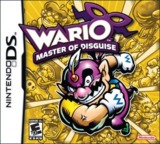It's not a Wario game, it's a Wario-themed game.
Levels are an awkward combination of platforming and puzzling. There's almost no action to speak of, except for the occasional encounter with some rather basic and uninteresting enemies. Usually you'll have to solve some sort of simple puzzle to make progress from one part of the stage to another. These puzzles eventually begin repeating endlessly with almost no variation, which becomes a huge drag. Instead of getting from point "A" to point "B," the game requires you to run around different mazelike stages searching in vain for some way to make progress to the next treasure. This can lead to very long and very aggravating periods of wandering looking for the one place where progress can be made. In between all of this are mini-games that must be played to unlock the chests containing the treasure Wario seeks. Like the game's puzzles, these games are fairly simple and repeat over and over, getting boring very quickly.
Wario's movement is controlled with just the D-Pad. Your other hand is required to use the stylus on the touch screen to control Wario's actions and change his costumes. Each of his different costumes allows him different abilities that are supposed to help him through different situations. The problem is, the game is very bad at recognizing the different patterns you draw on the screen in attempts to get Wario to switch clothes, and this can get very frustrating very quickly. Controlling movement with a single finger feels incredibly awkward as well, as it's apparent that this setup was only made necessary by the developer's insistence of implementing the touch screen into the game. This is even more aggravating because it would've been simple enough to switch costumes with a button press instead of forcing the touch screen controls on the player. It's actually a good thing, in a way, that there isn't as much of an emphasis on action in this game. If there was, these shoddy controls would get aggravating that much faster. However, it’s probably the controls that necessitated designing the game in such a manner, making them even more annoying.
The game's presentation comes off as a stale, sterile imitation of what a Wario game should be. Instead of the cel-shaded look of the older games, this game uses the rendered look that got old after the first Donkey Kong Country game. A system like the Nintendo DS should be able to create something better than this. Even the levels themselves are dull. Instead of adventuring across a giant living paint canvas or through a giant pinball machine like Wario has done in games past, Wario starts things out on a bland-looking cruise ship and proceeds to head off through several more boring areas. The music's a waste too. There are a few voice samples that repeat occasionally, but these by no means make up for any of it. It all just comes off as though the developers had no idea what a Wario game should be like.
Wario: Master of Disguise is a disappointment to say the least. Part of the blame can be placed on developer Suzak, who clearly aren't familiar with handling the Wario license. The Nintendo-developed games in this series were light-years ahead of this game in almost every way. It's a boring, awkward game where fun is replaced by endless wandering and a disappointing sense of what could have been, if perhaps Nintendo themselves had handled this (as they hopefully will in the future). If you want a Wario game, then by all means take the time to hunt down one of the old Wario Land games in the used games section of your local game store instead of picking this up. It's a bad game, and it's not worth your money.

